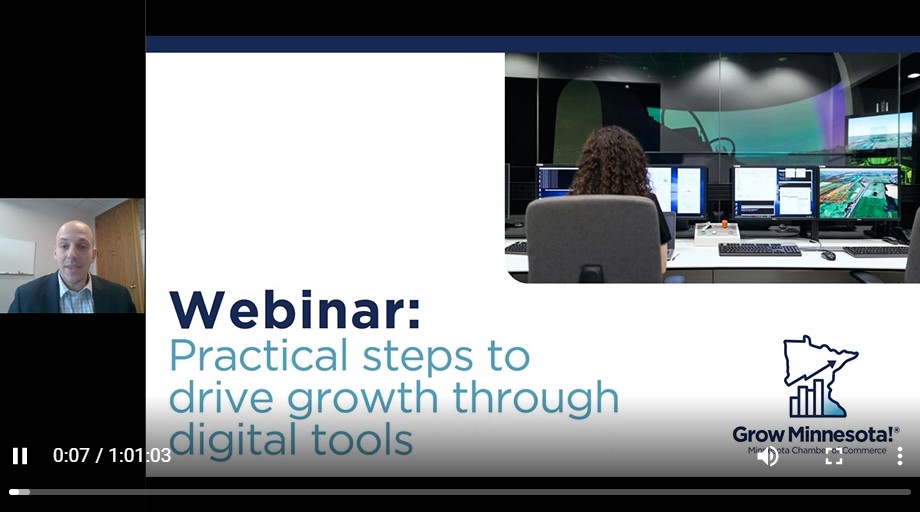How do Minnesota businesses leverage digital technologies?
Quick Menu
-
How are small and medium-sized businesses recovering from the pandemic-recession?
-
How are Minnesota SMBs investing in digital technologies and how is this impacting their recovery and growth?
-
What barriers do SMBs face to leveraging digital tools, and what can be done to help them compete in the digital economy?
-
Key recommendations
On-demand webinar: Identifying practical steps to drive growth through digital tools
As the below report from the Chamber's Grow Minnesota! program reveals, digital tools increasingly drive outcomes for small and medium-sized businesses. Yet, it can be difficult to navigate the flood of information and options available to businesses. This webinar will present a practical guide to identifying digital tools to find new customers, increase sales and leverage data analytics.

The Grow Minnesota! program surveyed 360 small and medium-sized businesses this summer to better understand how they are investing in digital technologies and what they need to better leverage these tools for innovation and growth.
Why is this important? A growing body of research shows that digital technologies are driving performance outcomes for small and medium-sized businesses (SMBs) in the U.S. and around the world. The COVID-19 pandemic only accelerated this trend.
As a report by IDC and CISCO states, “Once considered a way for companies to gain competitive advantage, digitalization has now become a matter of survival. The COVID-19 pandemic has exacerbated the digital divide that was already present in the small business market, and it is forcing companies to accelerate their digitalization.”
"
Helping businesses compete in the digital economy is thus a critical building block for Minnesota’s economic recovery and long-term economic growth.
"
However, research to date on digital technology trends among SMBs has occurred mostly at the national and international level.
Partnering with over a dozen local chambers and economic development groups, Grow Minnesota! surveyed businesses across the state this July through August and conducted in-depth interviews with small businesses, digital tech suppliers and business support organizations to gain further insights into this issue (see note on methodology).
Here is an overview of what we learned:
Key Findings – How are small and medium-sized businesses recovering from the pandemic-recession?
1. Over half of small and medium-sized business respondents have recovered to pre-pandemic levels and are optimistic about future revenue and hiring.
- Nearly 60% of SMBs have reached or surpassed pre-pandemic revenue levels. However, 16% are still more than a year away from full recovery.
- 51% of SMBs expect to increase employment and 59% expect to increase revenue levels over the next 12 months.
- Nearly 2/3 of businesses are having difficulty finding workers, potentially holding back the pace of recovery.
Key Findings – How are Minnesota SMBs investing in digital technologies and how is this impacting their recovery and growth?
2. Digital technology use and spending surged during the pandemic but is expected to moderate slightly in the coming year.
- 61% reported significant or moderate increases in digital technology use last year.
- Over 1/3 of businesses increased their digital technology spend by more than 25% last year.
- However, only 1 in 5 are expecting to increase tech expenditures by more than 25% in the coming year.
3. Businesses that view digital tools as a “core part of their business strategy” recovered to pre-pandemic revenue levels at a higher rate and were over 3x more likely to add jobs than less digitally focused companies.
- 64% of businesses said that “Digital tools are a core part of our business strategy and critical to our overall performance,” and 34% said that digital tools are “important to our business but do not drive our strategy or overall performance." Only 2% described digital tools as “not important to our business."
- A net 20% of businesses that view digital tools as a “core part of their business strategy” experienced employment gains last year, compared to only 6% for less digitally focused business. Digitally focused businesses were thus over three times more likely to experience job gains last year.
- SMBs report relatively low use of advanced technologies such as artificial intelligence, Internet-of-Things (IoT), and supply chain software. However, businesses that use these technologies report revenue gains at a higher rate than their peers who do not.
4. While some SMBs are rapidly adopting new technologies, most are making pragmatic and incremental changes. Respondents described focusing their efforts on gaining greater value from their existing tools and leveraging technology to gain customers and drive sales.
- Basic upgrades to existing technologies and incremental adoption of new tools make up the largest share of new business investments in digital tech, revealing a more pragmatic and moderate approach to digitalization among SMBs.
- When asked about the single most important digital tool or skillset that businesses would like to better utilize in their business, SMBs described a desire to expand digital marketing efforts and extract more value from their digital tools through leveraging data analytics, process automation and integration across tools and systems.
Key Findings – What barriers do SMBs face to leveraging digital tools, and what can be done to help them compete in the digital economy?
5. Respondents cited a.) lack of time to learn about digital tools, b.) uncertainty about ROI, and c.) cybersecurity threats as the three biggest barriers to adopting new technologies. Lack of digital skillsets among existing workers follows close behind.
- In talking with small businesses, tech companies and resource providers, two barriers were commonly repeated: small businesses leaders “don’t know what they don’t know” relative to digital tools and “don’t have time” to explore new technologies.
- Additionally, many businesses have concerns about cybersecurity threats and feel they don’t have the right technical skills within their workforce to leverage digital tools effectively. Time, knowledge and risk thus appear to be bigger barriers than cost alone.
6. Businesses view employee skill development and education/training about emerging technologies as key levers to accelerating digital technology growth. They also cite peer business leaders and tech suppliers/vendors as their preferred “go-to” resources for digital strategies.
- 41% of respondents view employee skill development as the key lever to accelerating digital technology use. Business owners can’t increase the number of hours in a day, but they can look to digitally savvy employees to identify solutions and lead on digital projects.
- Businesses need a range of resources to maximize digital technologies, from basic educational content to consulting programs to financial assistance. However, opportunities to talk directly with other business peers and with subject matter experts may be particularly valuable.
As one resource provider described:
“What small businesses really need are safe spaces where they can have honest conversations with other business leaders. This is the only time I’ve seen game-changing transformation occur for businesses.”
7. When asked what Minnesota can do to help SMBs compete in the digital economy, the most common response was access to high speed internet, followed by tax reductions or tax incentives to invest in digital technologies.
- A plurality of businesses said that better access to reliable, high-speed internet was the #1 thing Minnesota could do help businesses compete in the digital economy. Here are some examples of what businesses said:
- “Ensure high-speed internet is available and affordable in all neighborhoods. [Need] speeds of over 100 Mbps.”
- “Better wifi access for rural areas!”
- “Encourage investment in more cell towers in rural areas.”
- “Gig internet statewide that is so inexpensive everyone has it.”
- “Help fund rural communities to have access to reliable internet. The internet in our community is not anywhere near the reliability from another provider just down the road.”
- “Internet speed is a problem in my area. No availability of high-speed.”
- “Keep up with wireless infrastructure and allow more competition in geographies between suppliers.”
- “Need a more robust internet that services all of Minnesota. That is where it starts.”
- “Ensure high-speed internet is available and affordable in all neighborhoods. [Need] speeds of over 100 Mbps.”
- Tax policy was the second most common grouping of comments. Our interviews revealed that businesses typically invest in digital technologies from their cash flow rather than through financing. Within this context, it is perhaps not surprising that SMBs cited tax reductions or tax incentives as a preferred option to help them invest in digital technologies. Some businesses stated this in general terms:
- “General reduction in tax burden on businesses would help with investment in all areas of the business.”
- Others offered more specific ideas, such as:
- “Offer tax incentives for upgrading [out]dated technologies for business”
- “Create tax incentives for businesses to invest in marketing automation and digital marketing software.”
- “General reduction in tax burden on businesses would help with investment in all areas of the business.”
Key Recommendations:
Findings from our survey and interviews suggest that a variety of responses are needed to help small and medium-sized businesses maximize digital technologies. Action is needed across a range of stakeholders, from businesses themselves to economic developers and business support organizations to policymakers. Below are some examples of actions that could help Minnesota businesses better compete in the digital economy.
For businesses
- Incentivize motivated employees to develop and enhance digital skills. As one small business leader put it, “we look for those employees with some ‘chutzpah’ to go out and find opportunities to develop their digital skillsets.” Business leaders have an opportunity to accelerate digital strategies by giving their employees time and resources to develop new skills and implement them within their work.
- Extend your bench of talent through contractors/suppliers; examine the feasibility and ROI of increasing in-house tech skills. Several small business leaders described that they view their technology suppliers as key partners to help expand their digital capabilities. In many cases, leveraging supplier partners is a less risky and more affordable option as businesses move through their digitalization journey. Businesses can identify digital tech suppliers at no cost through the MN Supplier Match database.
- Utilize free and low cost digital tools. The cost of digital tools can be a barrier for many small businesses. However, businesses may be unaware of the numerous free and low cost tools currently available to them. Before leaders assume that digital solutions will be cost prohibitive, they should ask their peers or scan online for potential affordable tools.
- Leverage peer networks and existing business resources. Similar to free digital tools, businesses may be unaware of existing support organizations and resources that can help them navigate digital strategies. For example, Minnesota’s network of Small Business Development Centers and SCORE-MN chapters offer free consulting to small businesses and can provide assistance on issues like digital marketing or e-commerce. Other programs like Launch Minnesota’s new Minnesota Exchange program connect entrepreneurs with experienced business mentors to help them explore ideas and gain practical advice. View the Minnesota Chamber’s Economic Development Resources page to explore these and other such resources.
For chambers, economic developers and other business support organizations
- Help businesses more easily navigate information and educational content on digital tools. While educational content alone is not sufficient, it is a necessary first step to help businesses transition from “not knowing what they don’t know” to understanding the basic opportunities and tools available to them. Resource providers can act as trusted mediators to direct businesses to high quality content, helping them avoid “information overload” that business leaders often experience.
- Create spaces for businesses to have informal conversations with peers and subject matter experts. Businesses need a spectrum of resources. Webinars, online content and events are a good first step, but businesses may need more one-on-one consulting and peer learning opportunities to help navigate options. Support organizations can create spaces for businesses to converse and have honest conversations about important business challenges. This can take a variety of forms, but some examples include programs like CEO Next – an economic gardening program in the Twin Cities metro. Such models could be replicated and expanded to help businesses innovate and grow.
- Focus on solving core business problems first, with digital strategies being one potential tool in the toolbox. Several business leaders and resource providers explained that small businesses often seek assistance to solve a core functional issue (e.g. increase sales, improve financial reporting, etc.), and end up adopting a digital tool as one of several potential solutions at their disposal.
- Prioritize efforts to help businesses extract more value from their existing digital technologies. Many businesses already have adequate tools in place but would like to better utilize them through more advanced analytics, process automation and better integration across their IT tools and systems.
- Develop digital competencies within support organizations and partners. The quality of services provided by support organizations is only as good as the expertise and capabilities they bring to the table. Some business support organizations described that they have an internal focus to help their consultants/resource providers to gain greater digital literacy and expertise, so they can in turn provide greater value to their clients regarding digital strategies.
For policymakers
- Identify alternative solutions for businesses in areas without adequate access to reliable, high-speed internet. Expansion of high-speed internet continues to remain a top priority, particularly in more rural areas of the state. This may include alternative connectivity solutions, in addition to traditional broadband expansion.
- Research tax policy impact on business investments in digital technologies. Our findings revealed that many businesses invest in digital technology out of their cash flow rather than through financing tools. As such, tax policy can play a direct role in freeing up capital for asset-light investments such as digital technologies. Indeed, tax reductions and/or incentives was the second most common theme among SMBs when asked about policies or programs to help them compete in the digital economy. Improving Minnesota’s tax competitiveness and exploring innovative policy tools should be priorities to accelerate digitalization.
- Examine workforce training programs to better align with the realities of digital skillsets needed in the workplace. Workforce training programs and incentives are often tailored to help train workers on customized equipment or processes. Digital skills training, however, may be less customized or tied to a specific tool or set of equipment. Policymakers and economic developers should explore this further and identify training mechanisms that could accelerate digital skillsets in the workplace, from basic digital literacy to advanced skillsets such as programming and data analytics.
Next Steps
Grow Minnesota! will continue to examine this issue in coming months and work with our partners to further develop resources for Minnesota businesses to compete and thrive in the digital economy. We have begun this work already, making the MN Supplier Match and Economic Development Resources page available at no cost to businesses. We included new tools to help companies connect with local technology firms and navigate existing free resources related to digital technology needs. Look for further resources and opportunities in the months to come.





